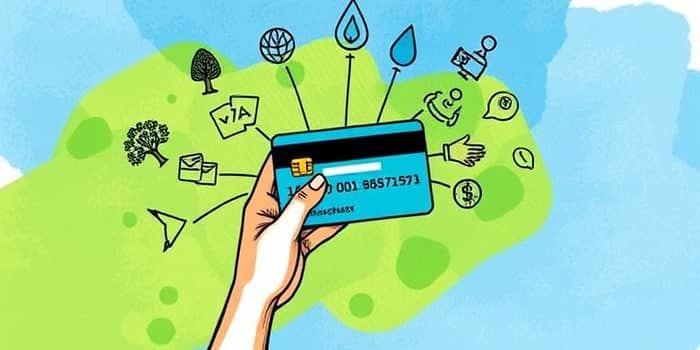In 2025, an inspiring wave of financial products is changing the way we think about everyday purchases. Align spending habits with personal values by choosing a credit card that invests in causes you believe in. Ethical credit cards empower consumers to direct a portion of their transaction fees toward meaningful and lasting change.
More than a payment tool, these cards serve as a statement of intent—a commitment to drive positive outcomes with every swipe. In this guide, we’ll explore what defines an ethical credit card, reveal top choices for 2025, and share practical steps for selecting the right card for your goals.
What Are Ethical Credit Cards?
Ethical credit cards are specialized financial instruments designed to channel a share of transaction fees into projects that advance environmental sustainability and social justice. Rather than remaining neutral, issuers commit to funding initiatives like reforestation, access to clean water, and educational programs for underprivileged communities.
Behind the scenes, merchants pay fees on each sale and card issuers allocate a set percentage of those fees to vetted charities. This approach transforms routine spending into a vehicle for supporting reforestation and clean water projects without altering your budget or decreasing your purchasing power.
Benefits of Ethical Credit Cards
Holding an ethical card offers all the traditional perks—cashback, points, travel insurance—while layering on a deeper sense of purpose.
Enjoy improved credit health through consistent, on-time payments and transparent account management that reflects reliable borrowing behavior over time. No matter the size of your balance, responsible use can elevate your credit profile and demonstrate fiscal discipline to future lenders.
Many cards feature incentivize sustainable consumer behavior programs, rewarding you with bonus points or extra contributions to environmental causes when you shop at certified green retailers. Some even unlock invitations to exclusive sustainability-focused events and discounts hosted by partner organizations.
Types of Ethical Credit Cards Available in 2025
The landscape of ethical credit cards has expanded significantly. Three standout offerings illustrate the diversity of options available:
Each card aligns with varied sustainability objectives. The Green America Visa focuses on social equity and environmental justice while the REI Mastercard channels funds directly into conservation. The Eco Impact World Mastercard caters to frequent travelers who wish to offset environmental footprints through reward redemptions.
How Ethical Credit Cards Support Sustainability
Ethical credit cards go beyond mere marketing—issuers evaluate loan portfolios based on responsible lending practices and investment. They apply environmental, social, and governance criteria to guide which industries receive funding and how returns are reinvested.
Reward programs can be structured to measure real-world impact of spending by tracking the collective outcomes of cardholder contributions. Some platforms offer dashboards that visualize planted trees or funded scholarships resulting from community-wide spending.
Certifications and Standards
To ensure legitimacy and avoid hollow promises, seek institutions that hold recognized certifications. Each standard enforces rigorous rules for accountability and transparency:
B-Corp certification demands a public commitment to social performance, environmental stewardship, and transparency and accountability at every level. The Global Alliance for Banking on Values (GABV) requires member banks to reinvest in sustainable projects. Community Development Financial Institution (CDFI) status highlights dedication to underserved markets.
Consumer Trends in Ethical Credit Cards
Today’s consumers are more financially empowered than ever to shape social change through spending choices. Microdonation models, green materials for card production, and partnerships with ethical retailers have become industry benchmarks.
Card users increasingly demand clear metrics and prefer brands that mirror their personal values. Surveys reveal that a majority of young adults are willing to pay moderate fees in exchange for guaranteed contributions to social causes and eco-friendly packaging.
Industry Implications
The rise of ethical credit cards is reshaping multiple sectors. Finance professionals are forging alliances with nonprofits to design bespoke donation channels. Technology firms are developing seamless integrations for real-time impact tracking on mobile wallets.
Charity organizations benefit from stable funding streams and increased visibility, while merchants that align with sustainability criteria gain higher customer loyalty and differentiated market positioning.
Regulatory Considerations
Regulators are tightening disclosure requirements to counteract greenwashing. In many jurisdictions, issuers must detail how they select causes, audit financial flows, and report outcomes. Compliance with guidelines like RG65 ensures that marketing claims align with documented practices and audited impact reports.
How to Choose an Ethical Credit Card
- Identify your core values—decide if environmental, social, or economic justice matters most to you.
- Examine issuers’ sustainability reports for clear targets and past performance.
- Compare fees, interest rates, and reward structures to match your spending habits.
- Verify certifications such as B-Corp, GABV, or CDFI to ensure third-party accountability.
- Explore user reviews and independent ratings for honest feedback on impact tracking.
Conclusion
Ethical credit cards offer a transformative way to empower personal spending with a higher purpose. By choosing cards that allocate resources to support socially beneficial community projects and uphold robust standards, you amplify your financial footprint and contribute to global sustainability goals.
As the market evolves in 2025, staying informed and intentional will help you harness every purchase as an opportunity for positive change. With practical tips and a growing roster of impactful products, your wallet can become a powerful instrument for good.
References
- https://www.spintheglobeproject.com/ethical-banks-and-socially-responsible-credit-cards/
- https://good-with-money.com/2025/03/27/top-3-ethical-credit-cards/
- https://thepaymentsassociation.org/article/ethical-credit-financing-a-sustainable-future/
- https://www.greenamerica.org/your-green-life/wanted-socially-responsible-credit-card
- https://www.fastercapital.com/content/Ethical-Credit-Cards--Spending-Wisely--The-Rise-of-Ethical-Credit-Cards-in-Conscious-Banking.html
- https://www.nerdwallet.com/article/investing/ethical-investing
- https://www.trendhunter.com/protrends/protean-ethical-how-socially-conscious-credit-cards-align-with-ethical-cons
- https://asic.gov.au/regulatory-resources/financial-services/how-to-avoid-greenwashing-when-offering-or-promoting-sustainability-related-products/










